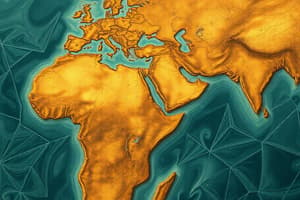Podcast
Questions and Answers
What is continental drift?
What is continental drift?
- The theory that suggests Earth's continents were created by asteroid impacts
- The theory that proposes Earth's continents were formed by volcanic eruptions
- The theory that suggests Earth's continents are stationary and unchanging
- The theory that proposes Earth's continents were once connected as a single landmass (correct)
What do fossils provide evidence for?
What do fossils provide evidence for?
- Earth's history, including past climate and distribution of life (correct)
- The alteration of pre-existing rocks
- The formation of igneous rocks
- The future movement of tectonic plates
What are rock types?
What are rock types?
- Three major categories of rocks: igneous, sedimentary, and metamorphic (correct)
- Two major categories of rocks: sedimentary and metamorphic
- Three major categories of rocks: volcanic, sedimentary, and metamorphic
- Four major categories of rocks: igneous, sedimentary, metamorphic, and volcanic
What are outlines in the context of continental drift?
What are outlines in the context of continental drift?
What is Pangaea?
What is Pangaea?
Flashcards
Continental Drift
Continental Drift
The theory that Earth's continents were once a single landmass.
Fossil Evidence
Fossil Evidence
Fossils reveal Earth's history, including climate and life distribution.
Rock Types
Rock Types
The three major categories of rocks: igneous, sedimentary, metamorphic.
Outlines of Continents
Outlines of Continents
Signup and view all the flashcards
Pangaea
Pangaea
Signup and view all the flashcards
Study Notes
Continental Drift
- Continental drift refers to the movement of the Earth's continents relative to each other
- The theory suggests that the continents have changed their positions over time and were once joined together in a single supercontinent
Fossil Evidence
- Fossils provide evidence for continental drift by showing that the same fossil species are found on different continents
- This suggests that these continents were once connected, allowing species to roam and migrate across the single landmass
Rock Types
- There are three main types of rocks: igneous, sedimentary, and metamorphic
- Igneous rocks are formed from molten magma, sedimentary rocks are formed from compressed sediments, and metamorphic rocks are formed from transformed existing rocks
Outlines
- Outlines refer to the fit or shape of the continents, which can be seen to fit together like a jigsaw puzzle
- The outlines of the continents provide visual evidence for continental drift, suggesting that they were once connected
Pangaea
- Pangaea was a single supercontinent that existed on Earth around 300 million years ago
- Pangaea began to break apart around 200 million years ago, eventually forming the modern continents we see today
Studying That Suits You
Use AI to generate personalized quizzes and flashcards to suit your learning preferences.



